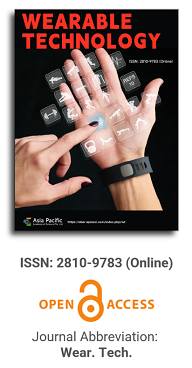

This paper delves deeply into the innovative realm of integrating human emotions with wearable technology. The primary focus is on the conceptualization and development of a kiss transfer device that harnesses the power of wearable technology to bridge the physical gap in human-human interactions. By investigating the intricate nuances of the human-human kissing process, the research seeks to replicate this intimate gesture through a technological medium. The paper not only elaborates on the anatomy, evolution, and hormonal dynamics of kissing but also underscores the transformative potential of wearable technology in capturing and transmitting these intimate moments. This exploration opens up new horizons for long-distance relationships, offering a tangible touchpoint that goes beyond traditional communication methods. Through this pioneering work, the research positions wearable technology as not just a tool for communication but as an extension of our human emotions and expressions.

Research on a monitoring and evaluation platform for mountain sickness of grid construction workers based on disease information entropy
Vol 1, Issue 1, 2020
Download PDF
Abstract
The inaccuracy of acute altitude sickness screening has brought great challenges to power grid construction workers in high-altitude areas. Human vital signs monitoring technology is an effective technical means to prevent people from developing altitude sickness. This paper proposes a monitoring and evaluation platform for high altitude sickness in power grid operations based on information entropy of the causes of the illness. First, the vital characteristics data of workers are collected through sensors such as blood pressure and blood oxygen. Secondly, the collected data is transmitted back to the platform by using the Internet of Things technology. The information entropy establishes an analysis model of altitude sickness and generates personnel evaluation reports and treatment recommendations. Finally, the application results of the platform verified that the preventive effect of the platform is much higher than that of the pre-existing physical examination method.
Keywords
References
- Cui J, Yang S. Summary of drug research on improving high altitude working ability (in Chinese). Medical Journal of National Defending Forces in Southwest China 2017; 27(12): 1358–1360.
- Tian Y, Wang W, Zhang H. An analysis of the incidence and risk factors of acute altitude sickness among visitors to Tibet (in Chinese). Practical Preventive Medicine 2019; 26(8): 975–977.
- Yuan X, Wu Z, Zha L. The correlation between cardiac function change and sleep quality in patients with chronic mountain sickness in Xining area (in Chinese). Chinese Journal of HealthCare and Medicine 2019; 21(4): 305–308.
- Liu X, Luo Y. The evolution and the latest progress of the diagnostic criteria of acute mountain sickness (in Chinese. Journal of Preventive Medicine of Chinese People’s Liberation Army 2019; 37(10): 188–192.
- Sun Z, Lin J, Zhu K, et al. Investigation and Analysis on the risk factors of acute high altitude disease in the constructors of high altitude power grid (in Chinese). Medical Journal of National Defending Forces in Southwest China 2016; 26(4): 460–461.
- Ma S, Shen M, Xia G. Analysis of eight year follow up data of plateau workers by color Doppler echocardiography (in Chinese). Chinese Journal of Industrial Hygiene and Occupational Diseases 2018; 36(8): 607–609.
- Liu H, Su J, Ma J, et al. The expression of VHL/HIF signaling pathway in the erythroid progenitor cells with chronic mountain sickness (in Chinese). National Medical Journal of China 2019; 99(34): 2670–2674.
- He X, Feng L, Du Y. Influencing Factors of severe acute mountain sickness (in Chinese). Chinese Journal of Social Medicine 2019; 36(2): 142–145.
- Wu Y, Bao H, Zhang H. Magnetic resonance and spectrum signal analysis on lumbar vertebra marrow in chronic high altitude disease (in Chinese). Journal of ClinicalRadiology 2018; 37(7): 1183– 1186.
- Wang H, Wang D, Yang K. Technical architecture and platform construction of distributed photovoltaic data sharing system based on internet of things identification technology (in Chinese). Power System and Clean Energy 2019; 35(8): 69–75.
- Wang X, Wang L, Wu D, et al. Design about intelligent inspection network scheme of distribution network based on edge calculation and LoRa technologies (in Chinese). Guangdong Electric Power 2020; 33(9): 42–48.
- Qian H, Jia S, Yang F, et al. Intelligent operation and maintenance technology for relay protection equipment based on mobile internet (in Chinese). Smart Power 2019; 47(11): 60–66.
- Ai J, Dang X, Lv Q, et al. Research on full dimension equipment status monitoring system with panoramic function (in Chinese). Power System Protection and Control 2019; 47(16): 122–128.
- He Y, Liang K, Tan W, et al. Security monitoring system of intelligent substation based on IoT (in Chinese). Telecommunications Science 2018; 34(9): 179–185.
- Shi Y, Chen C, Luo Y. Design and application of RTU pipeline terminal based on NB-IoT (in Chinese). Transducer and Microsystem Technologies 2019; 38(12): 157–160.
- Zhang P, Yang M, HE H. Function and application of Internet of things engine of smart Guangzhou spatiotemporal cloud platform (in Chinese). Geospatial Information 2019; 17(12): 47–49.
- Zhao N, Wang J, Zhang H, et al. Research and application of remote diagnosis and treatment for cardiovascular diseases based on internet of things (in Chinese). China Digital Medicine 2019; 14(12): 80–82.
- Xie Z, Li D. Research on key technologies of intelligent blood pressure monitoring system based on internet of things (in Chinese). China Digital Medicine 2019; 14(12): 36–39.
- Wang H, Gu S, Wan Y, et al. Research and application of 5G technology in power systems (in Chinese). Guangdong Electric Power 2019; 32(11): 78–85.
- Konreddy R, HeM. How to ensure security in the era of Internet of things? (in Chinese). Microcontrollers & Embedded Systems 2019; 19(12): 1–3.
Supporting Agencies
Copyright (c) 2020 Donglai Tang, Ying Yang, Ping Li, Juntai Tian, Hongfei Ye, Jin Guo

This work is licensed under a Creative Commons Attribution 4.0 International License.

Prof. Zhen Cao
College of Information Science & Electronic Engineering, Zhejiang University
China, China
Processing Speed
-
-
-
- <5 days from submission to initial review decision;
- 62% acceptance rate
-
-
Asia Pacific Academy of Science Pte. Ltd. (APACSCI) specializes in international journal publishing. APACSCI adopts the open access publishing model and provides an important communication bridge for academic groups whose interest fields include engineering, technology, medicine, computer, mathematics, agriculture and forestry, and environment.





